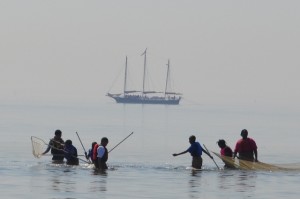Discover Long Island Sound
 Long Island Sound is this region’s most important and beautiful natural resource. Among the Northeast’s largest estuaries and most productive ecosystems, it is home to a vast array of marine life, such as fish and shellfish, as well as hundreds of species of birds and other mammals. The Sound is also a tremendous source of economic prosperity that bounds New York and Connecticut by over 600 miles of coastal shores, bays, inlets and beaches.
Long Island Sound is this region’s most important and beautiful natural resource. Among the Northeast’s largest estuaries and most productive ecosystems, it is home to a vast array of marine life, such as fish and shellfish, as well as hundreds of species of birds and other mammals. The Sound is also a tremendous source of economic prosperity that bounds New York and Connecticut by over 600 miles of coastal shores, bays, inlets and beaches.
Long Island Sound has enriched generations of lives. Upon its discovery by Dutch navigator Adriaen Block in 1614, so began centuries of Sound-wide recreational and commercial traditions, from beach-going and bird watching to fishing and shipping.
Over 21 million people live within an hour’s drive of Long Island Sound and its water quality is representative of the lands and waters that surround it, but also of the downstream effects from the activities of the region’s residents and industry. In fact, human impact has been the main contributing factor to the poor health of Long Island Sound.
Because those who benefit from Long Island Sound are also responsible for its vitality, it is critical that the public be educated on how changes to their daily lives will greatly impact the health and beauty of their greatest natural resource. For this reason, SoundWaters engages all communities, educates students and the public, and creates a regional ethic of environmental stewardship that will benefit the future health of Long Island Sound.
At SoundWaters, we gather data daily on Long Island Sound conditions – aboard our ship and at our Center. High school students work on long term research projects, middle school students gather water quality data, and elementary students conduct population surveys. At our Coastal Center, we offer the region’s only Teaching Aquarium where students and the general public can visit and see up close the many creatures that live in the Sound.

